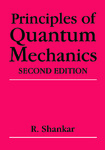Principles of Quantum Mechanics
Abstract
Over the decade and a half since I wrote the first edition, nothing has altered my
belief in the soundness of the overall approach taken here. This is based on the
response of teachers, students, and my own occasional rereading of the book. I was
generally quite happy with the book, although there were portions where I felt I
could have done better and portions which bothered me by their absence. I welcome
this opportunity to rectify all that.
Apart from small improvements scattered over the text, there are three major
changes. First, I have rewritten a big chunk of the mathematical introduction in
Chapter 1. Next, I have added a discussion of time-reversal in variance. I don't know
how it got left out the first time-1 wish I could go back and change it. The most
important change concerns the inclusion of Chaper 21, "Path Integrals: Part II."
The first edition already revealed my partiality for this subject by having a chapter
devoted to it, which was quite unusual in those days. In this one, I have cast off all
restraint and gone all out to discuss many kinds of path integrals and their uses.
Whereas in Chapter 8 the path integral recipe was simply given, here I start by
deriving it. I derive the configuration space integral (the usual Feynman integral),
phase space integral, and (oscillator) coherent state integral. I discuss two applications:
the derivation and application of the Berry phase and a study of the lowest
Landau level with an eye on the quantum H.all effect. The relevance of these topics
is unquestionable. This is followed by a section of imaginary time path integrals~
its description of tunneling, instantons, and symmetry breaking, and its relation to
classical and quantum statistical mechanics. An introduction is given to the transfer
matrix. Then I discuss spin coherent state path integrals and path integrals for
fermions. These were thought to be topics too advanced for a book like this, but I
believe this is no longer true. These concepts are extensively used and it seemed a
good idea to provide the students who had the wisdom to buy this book with a head
start.
How are instructors to deal with this extra chapter given the time constraints?
I suggest omitting some material from the earlier chapters. (No one I know, myself
included, covers the whole book while teaching any fixed group of students.) A
realistic option is for the instructor to teach part of Chapter 21 and assign the rest
as reading material, as topics for take-home exams, term papers, etc. To ignore it, I think, would be to lose a wonderful opportunity to expose the student to ideas that are
central to many current research topics and to deny them the attendant excitement. Since
the aim of this chapter is to guide students toward more frontline topics, it is more
concise than the rest of the book. Students are also expected to consult the references
given at the end of the chapter.
Over the years, I have received some very useful feedback and I thank all those
students and teachers who took the time to do so. I thank Howard Haber for a
discussion of the Born approximation; Harsh Mathur and Ady Stern for discussions
of the Berry phase; Alan Chodos, Steve Girvin, Ilya Gruzberg, Martin Gutzwiller,
Ganpathy Murthy, Charlie Sommerfeld, and Senthil Todari for many useful comments
on Chapter 21. I am most grateful to Captain Richard F. Malm, U.S.C.G. (Retired),
Professor Dr. D. Schlüter of the University of Kiel, and Professor V. Yakovenko of the
University of Maryland for detecting numerous errors in the first printing and taking the
trouble to bring them to my attention. I thank Amelia McNamara of Plenum for urging
me to write this edition and Plenum for its years of friendly and warm cooperation.

